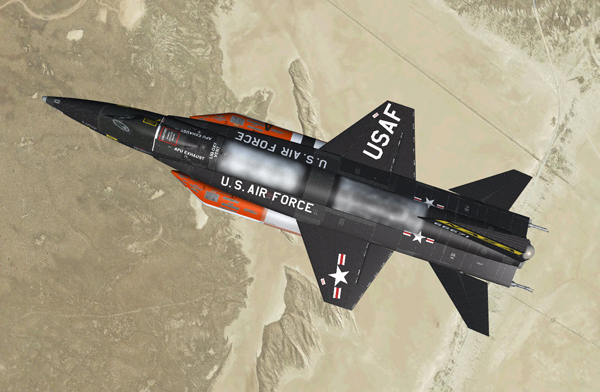
The X-15A-2 SE over the Mojave Desert.
The real X-15 was a single-place rocket-powered experimental aircraft built by North American Aviation in the late 1950's and early 1960's for NASA (NACA), the U.S. Air Force and the U.S. Navy to test flight at extremely high speeds and altitudes and to obtain data on the effects of such flight conditions on the aircraft and on the pilot.
The X-15 was capable of and achieved high speed and altitude records such as Mach 6.7 or 6629 fps (more than twice as fast as a speeding bullet) and 354,200 feet.
Three X-15 rocket planes were built during the X-15 research program, which overall cost more than $300 million (a colossal sum at the time). The program succeeded at demonstrating the ability of pilots to fly rocket-propelled aircraft out of the Earth's atmosphere and back to precision landing. Today, the X-15 can be considered as history's first reusable spacecraft.
After being dropped at a high altitude from a modified B-52 carrier airplane and propelled by its million-horsepower rocket engine at several times the speed of sound, the X-15 would fly to the edge of space, burn all its fuel, perform reentry into the atmosphere and finally glide its way back to land on a dry lake in the high desert of California.
The X-15-1, equipped with the "interim" Reaction Motors XLR-11 rocket engines, was rolled out in October 1958, and was transferred to Edwards Air Force Base for testing. Its first captive flight (while the X-15 is attached to the carrier airplane) occurred in March 1959 followed by its first glide flight in June of the same year. On January 23, 1960, the X-15-1, with NAA test pilot Scott Crossfield, successfully completed its first powered flight attaining Mach 2.53 and 66,844 feet with the two XLR-11 rocket engines.
In February 1961, the X-15-1 was returned to North American Aviation for conversion to its design-mission configuration (which required the powerful XLR-99 engine), after completing 21 flights with the XLR-11 engines.
NASA pilot Bill Dana flew the X-15-1 for the last time on October 24, 1968. The No. 1 aircraft completed 81 flights during the entire X-15 program.
The X-15-2 aircraft arrived at Edwards in April 1959 and made its first powered flight with the XRL-99 engine more than a year later, in November 1960, after completing nine flights with the XLR-11 engines.
In November 1962, the X-15-2 airplane was extensively damaged during an emergency landing, after the flaps refused to operate and the left landing skid failed. It was decided to rebuild the airplane as a modified "advanced" version of the X-15, with a longer fuselage and external propellant tanks. The "extended performance" X-15A-2 was rolled out in February 1964.
In October 1967, Air Force pilot Pete Knight took the X-15A-2 to Mach 6.7 (4520 mph), the fastest manned aircraft flight recorded to this day by a winged vehicle (excluding the Space Shuttle).
The X-15-3 was delivered to Edwards in June 1959, equipped with the XLR-99 engine. In August 1963, NASA pilot Joe Walker set an altitude record of 354,200 feet in the No. 3 aircraft. Sadly, the X-15-3 was lost in November 1967 after the airplane entered a hypersonic spin, descended in an inverted dive at almost Mach 4 and 65,000 feet and finally broke up, taking the life of Air Force pilot Michael Adams.
Together, the three aircraft completed 199 flights during a nine-year period, the 200th one being canceled several times in November and December, 1968. It was the end of the X-15 program.
After almost 40 years, the X-15 still holds impressive speed and altitude records. It was one of the most successful research aircraft tested at Edwards AFB.
Twelve test pilots flew the X-15: Michael Adams (USAF), Neil Armstrong (NASA), Scott Crossfield (NAA), Bill Dana (NASA), Joe Engle (USAF), Pete Knight (USAF), Jack McKay (NASA), Forrest Peterson (USN), Bob Rushworth (USAF), Milt Thompson (NASA), Joe Walker (NASA) and Bob White (USAF).
Today, the X-15-1 hangs from the ceiling in the main gallery of the Smithsonian National Air and Space Museum in Washington, D.C. The X-15A-2 is on display at the National Museum of the United States Air Force (Wright-Patterson Air Force Base, Dayton, Ohio).
See also:
External Links:
Research Project X-15 (video, NASA short)
US Air Force X-15 Hypersonic Aircraft (video)
X-15A-2 Flight Test with External Fuel Tanks (video)
X-15A-2 Side View of Damage After Mach 6.7 Flight (video)
X-15A-2 Approach and Landing (video)
North American X-15A-2 (National Museum of the USAF)
X-15 Walkaround (Smithsonian Air & Space)
Lecture at the National Air and Space Museum Smithsonian Institution by X-15 pilot Bill Dana
Joe Engle: The X-15, the Pilot and the Space Shuttle
Fact Sheet: X-15 Hypersonic Research Program
Note: Xtreme Prototypes is not responsible for the accuracy, legality or content of external websites. The inclusion of a link to an organization’s or individual's website does not constitute an endorsement or an approval. Information on linked website pages may become dated or change without notice. Please report any inappropriate content.